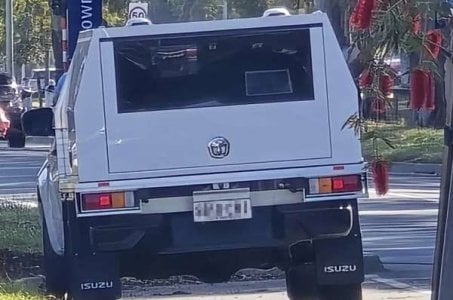This 'hidden' secret behind one ute is driving motorists wild. What could it be?
By
Danielle F.
- Replies 57
As Australian roads bustle with the usual traffic, authorities are now finding ways to catch drivers who break the law.
A seemingly innocuous ute has been turning heads and sparking debate among drivers.
An Isuzu ute has been recently spotted on a busy motorway, and it was not carrying tools or worksite equipment.
It, however, carried something on its closed tray: speed detection equipment.
The 'hidden' equipment ignited a fiery discussion among motorists, as some accused the police of using the unmarked vehicle for 'revenue raising'.
Other motorists took a different stance and argued that the presence of such equipment is a straightforward deterrent.
'If you don't speed, they won't get your money,' one argued.
A SAPOL spokesperson confirmed that their speed camera arsenal now included different vehicles.
'Since the retirement of the Holden brand in Australia, SAPOL's fleet now includes a variety of makes and models, which undergo testing to ensure they are suitable for use within SA,' the spokesperson shared.
'SAPOL employed a number of methods to monitor speed and driver behaviour on our roads, including overt and covert mobile speed cameras.'
Over a thousand motorists shared their opinions about the SAPOL's actions.
Some advocated for unmarked speed detection.
'If you're doing the right speed, there's no need to look out for them,' one commented.
'Don't do the wrong thing, and you won't be given a fine. It's as simple as that,' another echoed the sentiment.
However, some individuals expressed their frustration over the number of fines issued through roadside cameras.
'This is not about prevention but rather revenue! Otherwise, they would use branded vehicles,' a disgruntled driver remarked.
Another suggested that funds could be allocated to educating new drivers on road rules rather than revenue-raising tactics.
Despite the mixed reactions, SAPOL maintained its transparency by publishing the locations of its mobile speed cameras on its website.
This would let drivers know where the detection cameras are stationed throughout the day.
The fines for those caught by a camera range between $202 for driving less than 10km/h over the speed limit, to a hefty $1900 for exceeding the limit by 45km/h or more.
This 'hidden' detail in the back of the ute could be a reminder to all drivers about the importance of adhering to road rules.
It also raised questions about the balance between enforcement and education and the best methods to ensure road safety.

What's your take on this approach to speed monitoring? Is it a fair tactic in the name of safety, or do you think otherwise? Share your thoughts and experiences with us in the comments section below.
A seemingly innocuous ute has been turning heads and sparking debate among drivers.
An Isuzu ute has been recently spotted on a busy motorway, and it was not carrying tools or worksite equipment.
It, however, carried something on its closed tray: speed detection equipment.
The 'hidden' equipment ignited a fiery discussion among motorists, as some accused the police of using the unmarked vehicle for 'revenue raising'.
Other motorists took a different stance and argued that the presence of such equipment is a straightforward deterrent.
'If you don't speed, they won't get your money,' one argued.
A SAPOL spokesperson confirmed that their speed camera arsenal now included different vehicles.
'Since the retirement of the Holden brand in Australia, SAPOL's fleet now includes a variety of makes and models, which undergo testing to ensure they are suitable for use within SA,' the spokesperson shared.
'SAPOL employed a number of methods to monitor speed and driver behaviour on our roads, including overt and covert mobile speed cameras.'
Over a thousand motorists shared their opinions about the SAPOL's actions.
Some advocated for unmarked speed detection.
'If you're doing the right speed, there's no need to look out for them,' one commented.
'Don't do the wrong thing, and you won't be given a fine. It's as simple as that,' another echoed the sentiment.
However, some individuals expressed their frustration over the number of fines issued through roadside cameras.
'This is not about prevention but rather revenue! Otherwise, they would use branded vehicles,' a disgruntled driver remarked.
Another suggested that funds could be allocated to educating new drivers on road rules rather than revenue-raising tactics.
Despite the mixed reactions, SAPOL maintained its transparency by publishing the locations of its mobile speed cameras on its website.
This would let drivers know where the detection cameras are stationed throughout the day.
The fines for those caught by a camera range between $202 for driving less than 10km/h over the speed limit, to a hefty $1900 for exceeding the limit by 45km/h or more.
This 'hidden' detail in the back of the ute could be a reminder to all drivers about the importance of adhering to road rules.
It also raised questions about the balance between enforcement and education and the best methods to ensure road safety.
Key Takeaways
- An Isuzu ute on a South Australian motorway has been identified as having mobile speed detection equipment.
- SA Police confirmed that since the retirement of Holdens, their fleet has started including various vehicles equipped with speed cameras.
- The tactic of unmarked speed detection vehicles sparked debate among motorists, as some saw it as a revenue-raising strategy.
- SA Police started publishing the locations of their mobile speed cameras online, and fines for speeding depend on the level of the speed breach.








